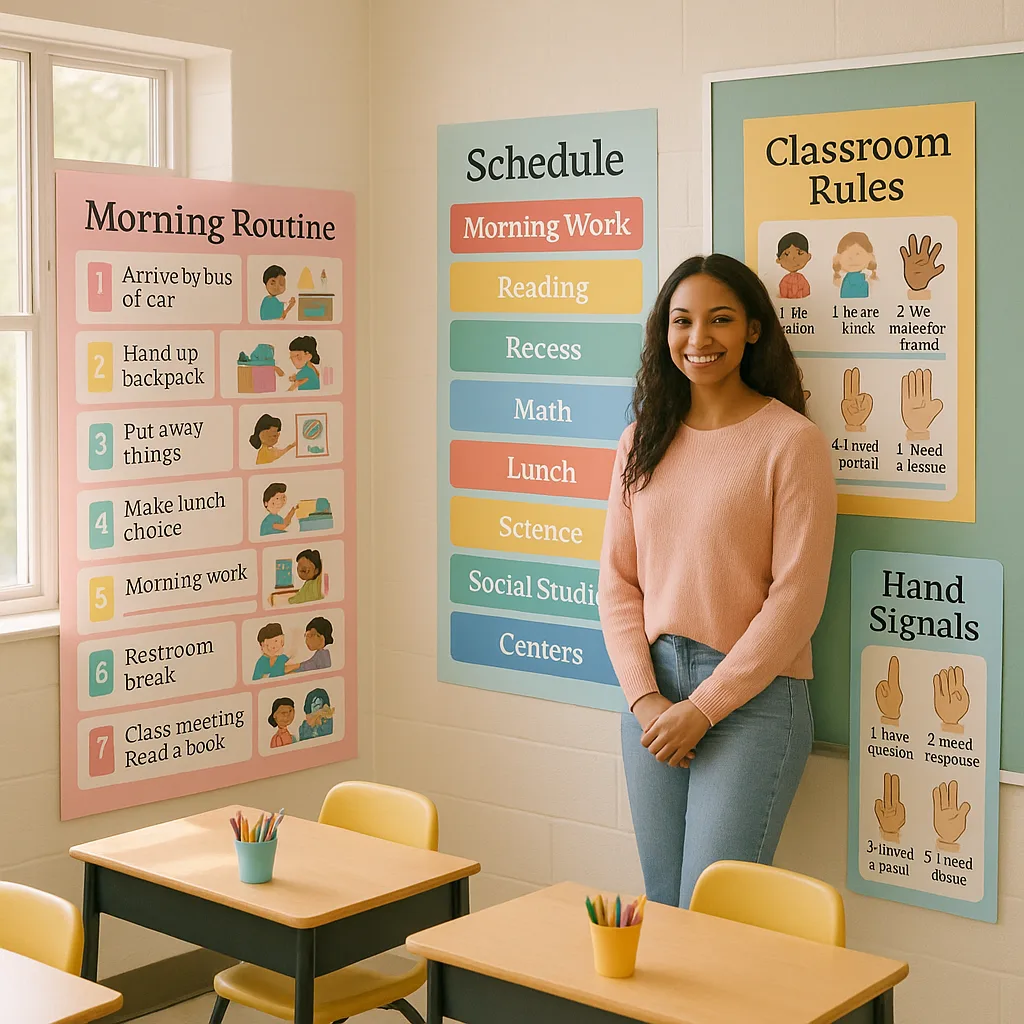Poster Machines First-Year Teacher Survival Guide
Remember how in college they told us about “classroom management,” but nobody really explained what that looks like on a random Wednesday when Tommy won’t stop making paper airplanes and Sarah is having her third meltdown of the week? Yeah, me too. That’s where having the right visual tools – specifically ones you can create with a school poster maker machine – becomes your secret weapon.
1. The Morning Routine Visual Schedule
This was my game-changer! Instead of repeating “hang up your backpack” 47 times every morning, I created a colorful step-by-step visual schedule. Research from the University of Kansas shows that visual schedules reduce transition time by up to 30% – and let me tell you, those minutes add up!

2. The Behavior Expectations Matrix
Forget those wordy classroom rules nobody reads. My behavior matrix shows exactly what “being respectful” looks like in different areas: classroom, hallway, cafeteria, and playground. Each section has simple icons and 3-4 bullet points max. One veteran teacher told me this single poster eliminated 80% of her “but I didn’t know” conversations!
3. The Voice Level Chart
Oh my goodness, this one saved my sanity! Instead of constantly shushing or asking kids to speak up, I just point to our voice level chart. Level 0 is silent, Level 1 is whisper, all the way up to Level 4 for outside voices. Each level has a fun animal mascot (mouse for whisper, lion for outside voice) that the kids absolutely love.
4. The Daily Schedule with Clock Visuals
First graders and telling time? Not always the best combo! That’s why my schedule shows both digital and analog clock faces for each activity. Plus, I color-coded subjects (math is blue, reading is red) which helps visual learners anticipate transitions. Having quality poster machines means I can update this whenever our schedule changes – no more crossing out and writing over old posters!
6. The Calm Down Corner Instructions
Every classroom needs a space for big feelings, but kids need to know how to use it. My calm down poster uses simple breathing exercises illustrated with fun shapes (breathe in while tracing the star, breathe out while tracing the circle). Dr. Patricia Jennings’ research on mindfulness in education shows that visual breathing guides reduce anxiety episodes by 60% in young learners.
7. The Clean-Up Checklist
“Clean up your area” means different things to different six-year-olds! My checklist has photos showing exactly what a clean desk, cubby, and floor space look like. Since implementing this with my school poster maker machine, clean-up time went from 15 minutes of chaos to 5 minutes of focused tidying. Victory! 🎉
8. The Hand Signals Reference Guide
Bathroom? Water? Pencil sharpener? These constant requests used to derail every lesson. Now, kids use silent hand signals, and I can just nod or shake my head while continuing to teach. The poster shows each signal with a photo of an actual student hand – way clearer than drawings!
9. The Growth Mindset Reminder Board
Instead of “I can’t do this,” we say “I can’t do this YET!” This poster shows simple swaps for fixed mindset statements. The visual impact of seeing these positive alternatives every day is incredible. Stanford’s research on growth mindset shows students with visual reminders are 40% more likely to persist through challenges.
10. The End-of-Day Reflection Prompts
This might be my favorite! Simple prompts like “Today I helped…” and “Tomorrow I want to try…” help kids process their day. I print these on coated poster paper so we can use dry-erase markers for daily responses. It’s become our cherished closing circle routine.
Design Tips That Actually Work
• Use real photos when possible – Kids connect better with actual images than clip art
• Limit text to 5-7 words per line – First graders are still developing reading fluency
• Choose contrasting colors – Yellow text on white background? Learned that lesson!
• Include white space – Crowded posters overwhelm little learners
• Make it interactive – Add velcro, pockets, or dry-erase surfaces where appropriate
Placement Strategies
• Eye level is key – Remember, kid eye level, not adult!
• Group related posters – All behavior management tools in one area
• Near point of use – Hand washing steps by the sink, not across the room
• Rotate seasonally – Fresh visuals maintain engagement
• Student work display – Reserve space for showcasing their creations too!
The Investment That Pays Off
Look, I know what you’re thinking – “Sarah, I’m a first-year teacher on a first-year salary!” Trust me, I feel you. But here’s what I discovered: having access to a school poster maker machine actually SAVES money in the long run. No more spending $30-50 on pre-made posters that don’t quite fit your needs. Plus, check out the actual printing costs – it’s way less than you’d think!
P.S. – If you’re feeling overwhelmed, take a deep breath. Teaching is hard, but you’re doing an amazing job just by seeking out resources like this. Your students are lucky to have a teacher who cares enough to make their learning environment better. Keep going, teacher friend! 💪


